With the prohibition on possessing bass on most NSW rivers from June 1 to September 1, many anglers some time this month will draw a line under the 2012-13 wild bass season.
I say ‘wild’ but many of our rivers are also subject to stocking under the dollar-for-dollar scheme, thanks to the activities of angling clubs. Fortunately, these days most of the broodstock is of a pretty close genetic strain to the resident fish in each waterway so there shouldn’t be much difference between the stocked fish and the true native bass.
So here’s a roundup of the 2012/13 wild bass season.
The north of the State experienced one of the driest Springs for some years, so much so that Tweed NSWFM reporter Roderick Walmsley says that the river became quite salty all the way up to the Bray Park Weir at Murwillumbah.
But that certainly didn’t stop some great bass fishing, especially early in the season, with hot surface bites occurring below the weir and in adjacent tributaries before the salinity became too strong and the fish dispersed.
Above the weir, the action was pretty good in the main until flows slowed in the dry weather and the fish became stressed, except in the cool of the evenings in the deeper holes.
Of course floods in January and February shut it all down for a while but there are now good bass to be caught downstream of Murwillumbah as the fish start to move in preparation for another spawning season.
The Richmond bass gathered to spawn around Swan Bay in icy weather in July-August before quickly moving up the Richmond and Wilsons arms as rain fell. They fed freely around the ‘good’ floodgates and drain entrances, mainly taking spinnerbaits and deeper crankbaits.
The removal in 2011 of the Manyweathers Weir at Casino gave the fish an easy run upstream to Kyogle in good flow that year.
But last Spring, dry weather and reduced flows made it a struggle, worsened by the neglected fish ladder on the Jabour Weir just upstream of the Manyweathers weir site. The council says it’s a Fisheries problem and Fisheries say it’s a council problem and the fish just say ‘dam!’
Fisheries banned possession of bass within a few hundred metres of the Jabour Weir to stem the slaughter, although the wording allowed catch-and-release anglers to capture fish in the prohibited area and release them above the weir.
On the Clarence, most bass seemed to spawn between Lawrence and the rocks at Maclean but then they hastened back to around Ulmarra-Grafton, where they spent a great deal of time feasting on shrimp, prawns and small herring. Blades, spinnerbaits and cranks did the job for the most part.
The subsequent dry spell meant few fish moved above tidal influence and apart from an early run after August rains, The Gorge didn’t really fire as well as it can.
The lower tributaries from Maclean to Ulmarra produced hot action at times in ever more brackish water as Spring merged into Summer. Fortunately there was plenty of riverine and terrestrial feed to keep the fish in exceptional condition.
Floods from Australia Day onwards wrote off most of the lower Clarence catchment but, as the headwaters cleared, the action there revived a little, indicating that some fish used the high water to head well upstream. Clarence flood records shattered, so there’s every chance there was a strong exchange of fish above and below The Gorge, where three waterfalls make a formidable natural barrier that is only rarely breached.
As the weather warmed there were vast shoals of freshwater herring in all northern systems and the Lucky Craft Sammy, and other surface dog-walkers, reigned. Some days the fish wanted a moving lure, on others they wanted it dead in the water for a minute or more but, after agonisingly tense waits, they would smash it viciously.
When the day got too bright, you could still entice surface bites in deep shade and the bass would often come up from sunken timber to whack something worked shallow, erratic and slow. The OSP Bent Minnow did that job like no other.
As soon as the weather warmed enough, the fish fixated on the prolific beetles and as November tapered down, there were prolific hatches of cicadas and nothing says ‘tasty cicada’ to bass more than the Tiemco Softshell Cicada.
Although there were some great cicada sessions in the foothills, the floodplain was exceptional, with Bungawalbyn Creek hitting its heights around Christmas. Santa could set me up on Bob and Diana Perry’s 300-plus riverside acres that were advertised in the March NSWFM issue – it’s right in the middle of cicada central.
Dave Seaman says the season on the Manning started with clean water with plenty of flow and good aquatic feed for the bass after they’d spawned. Crankbaits, spinnerbaits and plastics were effective.
The fish moved upstream quite quickly as conditions warmed and they established themselves well in the fresh headwaters.
Jointed Jitterbugs in 5/8oz and the ubiquitous Sammy were the key surface performers, while Jackall Chubbies and Crankas were good divers to cast. Gulp Minnows in 3” pumpkinseed and spinnerbaits in purple and black worked well in the middle of the day.
Two floods in a fortnight disrupted things and now the fish have moved down the system.
“If there’s more rain, the spawners will be from Killawarra down to Wingham by season’s end,” Seamo said.
The Hunter River bass came down almost to Raymond Terrace after some cold mornings and heavy rain around the end of last May, says Dave McLean.
Conditions at season opening were good, with water temps spot-on, and the fish moved back up the system pretty quickly.
The Williams River below the weir fished very well and the Paterson and the Hunter around Maitland also produced hot sessions as the fish moved to the upper tidal reaches, gorging on prawns as they went.
“As usual, most of the big fish seem to have stayed in the lower reaches for the season,” Dave said. “Unlike in 2011-12, there wasn’t much of a surface bite this season. There were not anywhere near the grasshoppers and other insects this season and I don’t know why. We had the heat, but not the bugs.”
Shallow-running crankbaits and spinnerbaits cast around the timber and rocks were the most effective lures for the season.
Local lure maker Maurie Marsden also got a lot of fish trolling his Marz lures along the banks. Similar action happened right up through the catchment to well beyond Singleton and Denman.
Dan Selby of Sydney Sportsfishing Adventures says it was an exceptional season on the river.
“I’ve never heard of or seen so many 50cm-plus fish; their numbers, size and the thickness of their bodies – it was insane,” he said.
“It’s impressive what a flood can do. We had a half-decent flood in 2011 and a good one this year.
“The floods released a lot of fish from the swamps, backwaters and private dams all through the catchment and the fish made it back into the river and became more accessible for the average angler.”
Dan says the fish stayed down-river for most of the season and were often caught downstream of where he was catching mulloway.
Spinnerbaiting the rock walls and tree snags produced some of the biggest fish this season, with Greg Beattie’s 63cm tail-length fish the big head-turner. Dan says up to 70 fish in a session became common and the creek mouths went insane at times on surface and subsurface lures.
“The next five to 10 years are going to be phenomenal on the Hawkesbury, what with the extra recruitment as these fish breed and the clean-out of all that choking weed growth,” he said.
Dean Dawson at Batemans Bay says the local season started a lot slower than in 2011 after rain from a bunch of east coast lows kept rivers and creeks dirty and high. “The fish moved altogether and we had to wait for the flooding to settle before we could get a look-in,” he said.
“When they finally went over Shallow Crossing, a local told me they were flapping on their sides in 15cm of water and you could have scooped them up if you wanted to.
“Things were good until January, when the river dried up again and got really tough. In spots where I was catching fish in 2011 I was looking at the snags 1m above the water. But apparently when it did rain again the fish really went crazy.”
Dean said numbers were down on 2011-12 but the size was still good, with plenty in the mid-40s.
Dean’s mate Ray Smith did a lot better at night this season and had lots of good surface sessions. The Illawarra-built Nutterjucks were hot lures, as was Kokoda’s Bat, the imitation of the hard Tiemco Cicada. Dean’s mother-in-law Maddie was ‘pretty possessive’ of her Megabass Siglett, too.
Darren Redman of DJ’s Xstream Fish’n Charters says when the Winter 2012 east coast lows deluged the area the fish from Brogo Dam rode down the spillway and into the Bega River, ‘as usual’, providing plenty of broodstock for the spawning season.
The fish moved back up the Brogo and in late October and early November were spotted milling around below the dam. “Fisheries and the Far South Coast Bass Stocking Association now have made it so they can’t be trapped there and die or be expoloited,” Darren said. “The fish can now filter back down the river.”
Good fish hung in the upper Bega River around Jellat Jellat in the deeper pools and in the feeder channel to Penuka Swamp, providing great action. Fish to 50cm were taking a variety of lures from small hardbodies to surface lures and some of the keen fly fishers took them on cicada imitations in early and mid-Summer.
“ It wasn’t a great cicada season but there are always a few that fire up in the she-oaks and willows around Bega for good action as the nor’-easters drop away on a summer evening,” Darren said.
Through the Brogo system, any deep hole from the Bega junction up to Brogo Dam held mixed sizes of fish. Access though private property is always a problem on this impressive stretch of water but those endured long walks experienced the best action on fish to 50cm.
More recently the black crickets have made a big showing and the bass have dined extensively on them
Lack of rain in the latter part of the season has had a serious influence on the river systems with seriously reduced flows.
“But the holes gouged out by the floods of the past few years have still contained plenty of fish and their condition hasn’t suffered,” Darren said.
Reads: 8037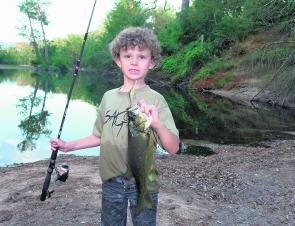
Young Joshua Smith terrorised the Manning River bass with a string of fish around 50cm.
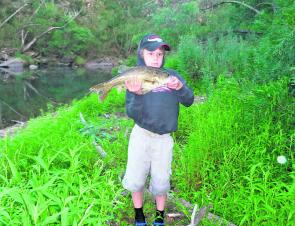
Joshua Smith at it again on the upper Manning.
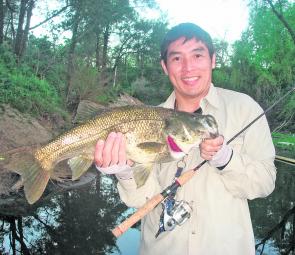
Fook-Chee Tam bagged this sensational 59cm bass in the Nepean River at Penrith in early October on a Smilin’ Jack Raw Prawn fished from the bank.

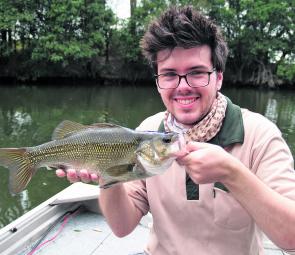
Shady, undercut banks and tidal bass go hand in hand.
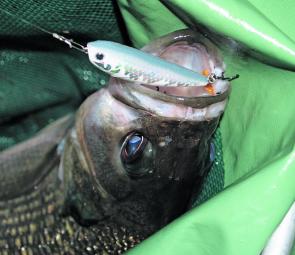
The Lucky Craft Sammy has a strong following among surface casters, especially when the fish are chasing herrings.

Most of the fish were in prime condition early in the season but low river flows produced a few lesions on fish during the dry spells.
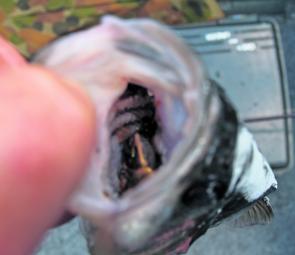
For a while there, every bass on the Northern Rivers seemed to have a gullet full of Christmas beetles.

The headwaters fished well until the floods came and were first to clear when they went. There are few better ways to spend a hot day than wading up and down the river.
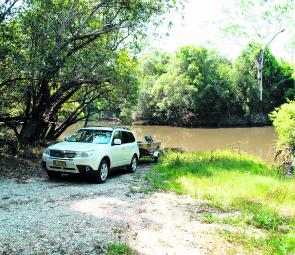
Launching at a naturally formed ramp: You can almost hear the cicadas.

On the good days, the fish kept biting all day long.

The upper Richmond produced plenty of quality fish until it almost stopped flowing in places.




